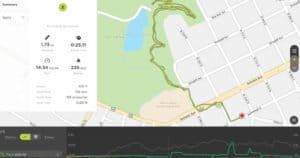To answer the question, we first need a very rudimentary science lesson.
Building muscle requires a person to increasingly challenge their muscles to face higher levels of resistance and/or weight. The result of this process is fibers that make up muscles begin to break down. The body then responds by repairing the damaged fibers, resulting in increased mass and size of the muscle–aka, building muscle.
3 Ways Rucking Builds Muscle
Rucking absolutely builds muscle. The additional weight carried while rucking builds muscle and strengthens your legs, core, shoulders, and back.
- Rucking Builds Muscle in Your Legs – In general, your legs have adapted to carrying your body weight. By adding additional weight to your body, via the ruck, you are increasing the amount of resistance your legs must endure over time. This continued resistance will produce the muscle hypertrophy noted above, building strength in your legs. (FWIW, we recommend the GORUCK Rucker and Ruck Plates).
- Rucking Builds Muscle in Your Core – By adding additional load to your back, muscle engagement in your core will increase to stabilize the load and protect your back. While your load should be secure, your body will notice increased weight and movement of the ruck as you walk. To compensate and keep you upright, your core will naturally engage in greater capacity than when walking under your body weight. This increased muscle use can build muscle in your core.
- Rucking Builds Muscle in Your Shoulders and Back – The added weight of the ruck will distributed across your shoulders and back. As you ruck, the increased load will cause your shoulders and back to engage at a greater rate than is normal, causing the muscle to respond to the increased weight. Over time, this will build muscle in your shoulder and back. (Note: We have a post about keeping your back safe while rucking if you’re interested.)
Muscle Gain Through Rucking Will Vary
As with any physical endeavor, the impact will be relative to your personal level of fitness. A deconditioned person just getting started with rucking will likely see far greater muscle gain as compared to a highly active athlete that works out 3-5 days a week.

Also important to the equation is the weight of the ruck and distance covered. While a person should ease into rucking and increase distance and load over time, generally speaking going heavier and longer will produce greater results. (Here is a helpful training plan for those looking to start rucking.)
Rucking Alone Will Not Get You Jacked
If you want to build huge muscles (aka, look like Bobby in the picture above) rucking alone will not get you what you’re looking for.
In order to build muscle, in the bulging-biceps and killer-quads kind of way, you’ll need to add strength training to your rucking. If you aren’t looking to hit the gym or spend any additional funds, adding in a Ruck Workout is a great way to build more muscle.
Benefits of Rucking Besides Muscle Gain
While rucking will certainly help build muscle, there are several other physical benefits like cardiovascular endurance and overall health.
- Rucking Is a Functional Movement – The ability to carry heavy loads over long distances is about as functional a skill as can be acquired. Regularly rucking under a heavy load equips you for better movement and durability throughout life.
- Rucking Increases Cardiovascular Endurance – Rucking increases the body’s need for oxygen and energy to carry load over distance. Regularly subjecting your body to this oxygen and energy need will result in increased cardiovascular endurance over time.
- Rucking is Great for Overall Health – Studies support that regular exercise, like rucking, can result in reduced anxiety, improved sleep, improved blood sugar control, and significantly lower risks of heart disease, high blood pressure, Type 2 diabetes and cancers (including bladder, breast, colon, endometrium, esophagus, kidney, lung and stomach). In addition, physical activity can reduce the risk of dementia, including Alzheimer’s disease.” (link)
Conclusion
Rucking can and will build muscle. The amount of muscle depends on your current level of physical activity and the weight, distance, and frequency you ruck. Of course, adding a ruck workout will certainly help as well.
Regardless, the benefits of rucking in both muscle gain and other areas supports adding rucking as a regular feature of your overall physical training plan.








6 Replies to Does Rucking Build Muscle?
Comments are closed.
Comparing the GORUCK Rucker and Ruck Plate Carrier: A Detailed Guide for Beginners
Is Rucking Better Than Running?
Best Rucking Backpacks List
How to Ruck Faster – 8 Tips to Speed Up Your Pace
What is Rucking?
Is Rucking Better Than Running?
Best Rucking Backpacks List
How Many Calories Do I Burn Rucking?